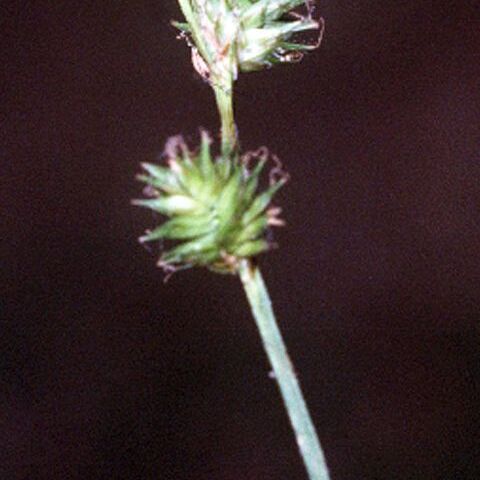Plants cespitose. Culms 45–100 cm; vegetative culms few, inconspicuous, usually fewer than 15 leaves, not strikingly 3-ranked, leaves clustered at apex. Leaves: sheaths green or with white intervenal areas, often adaxially white-hyaline, summits U-shaped or prolonged to 2 mm beyond collar; sheaths finely papillose or smooth; distal ligules 1–3 mm; blades 3–5 per fertile culm, 15–30 cm × 1–3.5 mm. Inflorescences arching or nodding, ± open, green to light brown, 2.5–6 cm × 4.5–11 mm; proximal internode 3–18 mm; 2d internode 3–13 mm; proximal bracts scalelike or with bristle tips shorter than inflorescences. Spikes 3–10, distinct, ellipsoid to globose, 6–16 × 5–6.5 mm, base acute to attenuate, apex rounded; terminal spike with conspicuous staminate base. Pistillate scales white-hyaline with white, green, or gold center, broadly lanceolate, 2.3–3.8 mm, shorter than and narrower than perigynia, apex acute. Anthers 1–2.1 mm. Perigynia (20–)25–60 in larger spikes, spreading, pale green to yellowish brown, conspicuously 5-veined or more abaxially, veinless or mostly indistinctly or basally 2–4(–6)-veined adaxially, orbiculate to elliptic, plano-convex, 2.5–4.2 × 1.5–2.3(–2.5) mm, 0.4–0.6 mm thick, nearly leathery, margin flat, including wing 0.3–0.6 mm wide, smooth; beak green or light brown at tip, flat, ciliate-serrulate, abaxial suture with conspicuous white-hyaline margin, distance from beak tip to achene 0.8–1.7(–2) mm. Achenes ovate, 1.2–1.8 × 1–1.3 mm, 0.3–0.4 mm thick; style sometimes abaxially-adaxially bent at base. 2n = 68, 70.
More
Tufted, aphyllopodic, the slender stems 5–10 dm, surpassing the lvs; main lvs 2–5 mm wide; sheaths ventrally hyaline; spikes 4–10, gynaecandrous, ovoid to subglobose, 6–16 mm, often distinctly clavate at base, sessile, distinct but crowded in a compact cluster or moniliform infl 2.5–6 cm; pistillate scales ovate, much shorter and narrower than the perigynia, hyaline and lightly brown-tinged, acute or acuminate; perigynia planoconvex and conspicuously winged, 2.5–3.5 × 1.5–2.2 mm, less than twice as long as wide, broadest at a third to half their length, the body suborbicular to broadly elliptic, finely nerved on both sides (the ventral nerves 5 or fewer and often indistinct), abruptly narrowed to the flat, serrulate beak, the wing-margins not reaching the tip; achene lenticular, 0.95–1.2 mm; style straight or bent at the base; 2n=ca 68. Marshes, woods and low ground; Mass. to Ont. and Ill., s. to Ga., Miss., and Tex. (C. straminea, misapplied)

